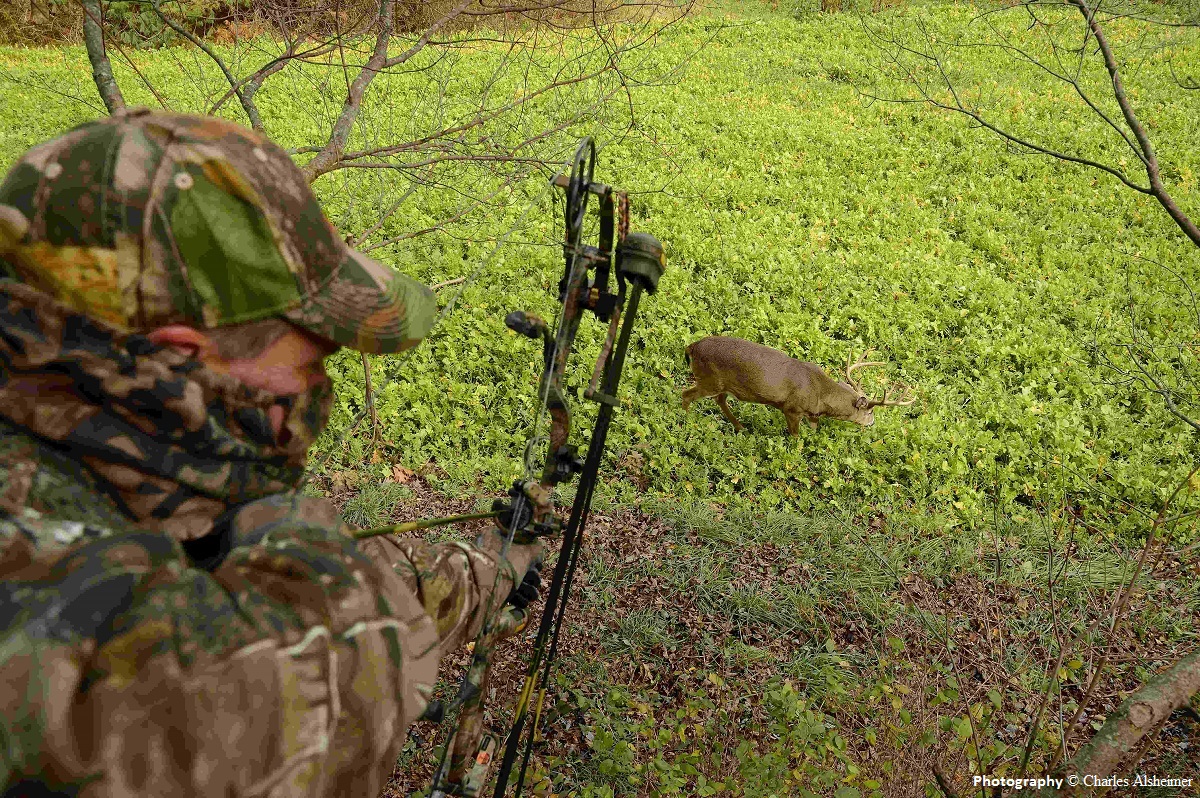Few things in life are as exhilarating as a string of frosty autumn mornings. Add in the chance to witness a forest’s green canopy changing to fiery gold and red, and you have the recipe that makes autumn so stimulating to the senses. In many ways autumn is the crowning moment in the whitetail’s yearly journey.
Historically, what goes on in the whitetail’s world in October generates far less interest than what follows in November when the rut is raging. Except for the tail end of October buck sightings are tough to come by. On the other hand, does typically continue their normal movements. With doe sightings normal and bucks sightings rare, hunting can be frustrating, especially during the first 20 days of October. For this reason hunters across the northern portion of the whitetail’s range call this period “the October lull.” This is not imagined for there are many reasons why bucks seem to shut down prior to November’s rut.
 This photo of a buck and full moon pretty much sums up the October Lull…..whitetails during October are primarily “night owls”. Daytime sightings are hard to come by.
This photo of a buck and full moon pretty much sums up the October Lull…..whitetails during October are primarily “night owls”. Daytime sightings are hard to come by.
The Fur Factor
Of all activity suppressors, air temperature is perhaps the most powerful influence on daytime deer activity. Warm temperatures shut down deer activity in a heartbeat. By the time October arrives the whitetail’s winter coat has grown in to the point that they cannot tolerate heat, especially if the temperature exceeds 60 degrees in the North. Unlike humans whitetails have no sweat glands to help them cool when temperatures rise. So, if October is unseasonably warm bucks will bed throughout the day, limiting their movement to the last two hours of daylight and through the night.
 Bucks during October spend 90% of daytime activity bedded.
Bucks during October spend 90% of daytime activity bedded.
Food
Throughout October hard and soft mast (acorns, apples, etc.) are falling and standing cornfields have matured along with a host of other food sources. With food seemingly everywhere all whitetails gorge themselves, with 90% of their feeding occurring under the cover of darkness. Research shows that from late August through the end of October it’s not uncommon for bucks to increase their body weight by 20-25 percent.
 During October bucks gorge themselves on food plot forage, ag crops, apples and hard mast like acorns.
During October bucks gorge themselves on food plot forage, ag crops, apples and hard mast like acorns.
If food is readily available in a buck’s core area the amount of territory he covers during October will be minimal, especially during the first 20 days of the month. Various studies have repeatedly shown that bucks travel little until late October when their hormone levels ramp up. In the early 1990s the New York State Department of Environmental Conservation began radio-collaring whitetails near our farm in western New York to determine their movement patterns. Our farm was in the study area so on occasion I was able to travel with the biologists as they monitored various bucks. It was amazing to see how predictable both bucks and does were during the first ten months of the year. If food was available the bucks being monitored didn’t cover more than a square mile of territory, until late October. Then things changed.
Hormones
In a whitetail buck’s world sex drive changes everything. From January through mid-October their sex drive is minimal. By early September, a buck’s serum androgen levels trigger the velvet-peeling process and the rutting season technically begins.
 Sparring increases as October inches toward November, some of which can turn ugly.
Sparring increases as October inches toward November, some of which can turn ugly.
Once velvet has peeled (in the North around September 1st) a buck’s hormone level begins to rise. Between September 1st and October 1st it doubles from summer levels. Though a buck’s sex drive begins to increase by early October their quest for food, disdain for heat, and does being a month or more away from entering estrous keeps them calm, cool and collected. As a result they continue to travel little, spending the majority of daylight bedded. But this is about to change.
With each passing sunset a buck’s hormone level increases and by the end of October his testosterone level is twice what it was when the month began. Simply put, hormones are the primary trigger of the different types of rutting behavior exhibited by a buck. Their stimulating effect can be seen in rubbing, scraping and breeding behaviors.
Rutting Behaviors
Other than occasional sparring matches between subordinate bucks witnessing rutting behavior in early October is rare. By mid-October shortening day length and near peak hormone levels cause bucks to travel, scrape, and rub more as the rut approaches. In my part of the world (western New York State) significant scraping activity begins October 10-15 each year. By the 25th of October more and more rubs show up in prime travel corridors and new bucks show up on our trail cameras, signaling an end to “the October lull.”
 Whitetails scent marking their core area with rubs and scrapes is intense by the end of October.
Whitetails scent marking their core area with rubs and scrapes is intense by the end of October.
A Day in the Life
October 1-20: North of the 35th latitude (Charlotte, NC to Oklahoma City, OK) heat can be significant during the early part of October. Because of this bucks and does will feed throughout the night, head for their prime bedding area about an hour before sunrise and stay bedded until just before nightfall. In most cases bucks will bed close to their prime food sources, in the thickest cover they can find. Content to bed, rest and feed most bucks will stay in a core area consisting of less than 1,000 acres.
October 21-31: During this time frame a buck’s infusion of testosterone will begin taking effect, causing them to cover more ground, in some cases 2,000 or more acres. In addition they seemingly work overtime to scent mark their territory by making scrapes and rubs. Sparring and fighting also become a big part of their daily routine. If day time temperatures are at or below normal bucks will be very active the first and last two hours of daylight.
 Hunting the last two hours of day light, in and around primary food sources is the key to being successful in October.
Hunting the last two hours of day light, in and around primary food sources is the key to being successful in October.







